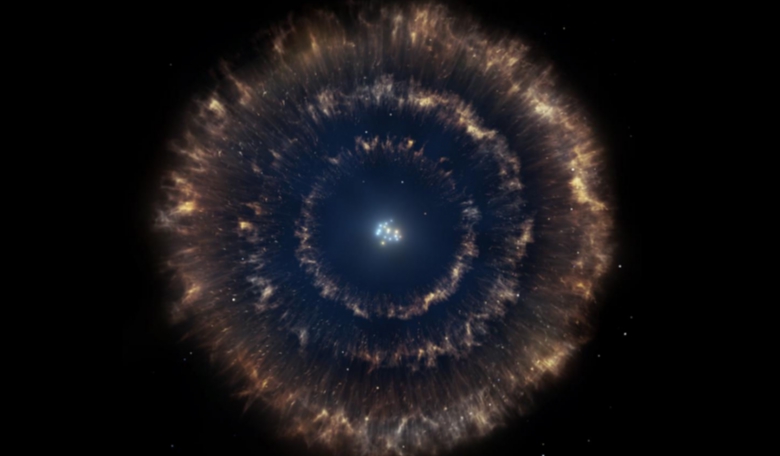The first ever known case of three supernova remnants inside one another, nested much like the Russian matryoshka dolls, has been discovered by researchers at the Instituto de Astrofisica de Canarias (IAC), an astrophysical research institute located in the Canary Islands. During observation of the M33 galaxy (also known as the Triangulum galaxy, the M33 is the third largest member of the Local Group, with an estimated mass of between 10 and 40 million times that of the sun) with the BUBBLY program (a method for detecting giant expanding bubbles of gas in interstellar space), researchers discovered a triple-bubble. The results of their research were published in the Monthly Notices of the Royal Astronomical Society.
This is the first time that researchers have found three concentric expanding supernova shells. Superbubbles are created by strong stellar winds and supernova explosions of individual stars, and are very varied in size and structure. The reason for the particular concentric effect observed by astronomers is that the supernovae exploded at short intervals (only about 10,000 years between explosions), which makes the explosions almost simultaneous on the astronomical timescale – as a result, they are still spherical and surround their parent star cluster.
The research group used a high resolution 2D spectrograph (Galaxy Halpha Fabry-Perot System, or GhaFaS) on the William Hershel Telescope to detect these superbubbles. According to the measurements obtained in the course of the study, the bubbles vary in size from a few light years to a thousand light years across.

Maps of the three concentric bubbles in the M33 galaxy show that as the bubbles grow in size around the star cluster, the speed of expansion decreases.
Credit: Artemi Camps Fariña (IAC)
According to John Beckman, one of the co-authors of the paper, "This phenomenon allows to explore the interstellar medium in a unique way, we can measure how much matter there is in a shell, approximately a couple of hundred times the mass of the sun in each of the shells". Artemi Camps Fariña, another author who worked on the paper, notes that "It must be that the interstellar medium is not at all uniform, there must be dense clumps of gas, surrounded by space with gas at a much lower density. A supernova does not just sweep up gas, it evaporates the outsides of the clumps, leaving some dense gas behind which can make the second and the third shells. The presence of the bubbles explains why star formation has been much slower than simple models of galaxy evolution predicted. These bubbles are part of a widespread feedback process in galaxy disc and if it were not for feedback, spiral galaxies would have very short lives, and our own existence would be improbable".
This discovery provides the researchers with a unique opportunity to study new aspects of star formation and supernova explosions.











